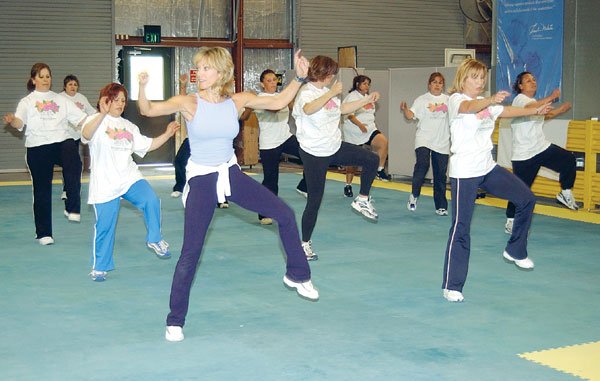GILROY
– Goldsmith Seeds employees are combining workdays with workouts
as part of a fitness program aiming to create a healthier workforce
and cut health-care costs for the company.
GILROY – Goldsmith Seeds employees are combining workdays with workouts as part of a fitness program aiming to create a healthier workforce and cut health-care costs for the company.
The voluntary program includes on-site strength training, yoga and Weight Watchers programs, with half the cost picked up by Goldsmith. About five months into the yearlong experiment, employees say they feel more energized, and Goldsmith has realized a 10 percent drop in health insurance claims. Absences also are down, and employees say they feel less on-the-job stress since the program began.
“The goal was for the employee to be a little bit more conscious about their health and feel better about themselves, and we’ve noticed a tremendous, tremendous change with regards to employees coming to work and feeling better about themselves,” said Lorena Munoz, Goldsmith’s human resources assistant.
On a personal level, some workers say they are meeting long-held weight-loss goals and feel stronger, healthier and more productive.
“I used to feel real tired around this time,” Imelda Jimenez said after spending her lunch break in a strength-training class just outside her office door. “After taking this class, I don’t feel tired or sleepy or anything – I’m just ready to go.”
About 80 percent of U.S. companies with 50 or more workers have some type of wellness program for employees, according to a report compiled by the Wellness Council of America, an Omaha, Neb.-based nonprofit that promotes healthier lifestyles. Some wellness programs are strictly educational, providing literature or classes on topics like smoking cessation and nutrition. Others, like Goldsmith’s, are more developed and include opportunities at the workplace to sweat or weigh in on a regular basis.
About 55 of Goldsmith’s 170 employees take part in the program. Strength training and yoga cost employees $5 a week each, and the Weight Watchers program is $109 for 22 sessions.
Strength training
In a warehouse to the rear of Goldsmith’s flower-covered grounds, workers begin to arrive to work out with Deb Smith, a fitness professional and personal coach who leads a strength-training class here four days a week.
The warehouse is called the mill, where 850 varieties of seeds are processed and tested throughout the year. Air ducts stretch across the ceiling and machinery hums in the background. But with boom-box workout tunes, a big exercise mat laid out across the cement floor, and a jumbo-sized supply of upbeat encouragement, Smith soon has a dozen or so Goldsmith workers pumping barbells, crunching abs and lifting knees in unison.
“Look how strong you are,” she calls, as she works out with the class. “Good job, guys. Just two more.”
There are a few groans and a short burst of laughter from the class as some under-utilized muscles are called to duty. Many employees have been busy with a yearly promotional event and haven’t been able to attend the workout for the past week. They’re paying the price today.
“Up, cross, up, down,” Smith continues. “My arms are shaking. Are your guys’ arms shaking a little bit?”
Jimenez, whose job is to test a variety of flower seeds to see how well they germinate, attends each of these workouts. She has the option of giving up her lunch break or staying at work 30 minutes late to make time for the class. Before the wellness program, she used to work out with videos at home. She says she gets more out of Smith’s class.
“I love it,” Jimenez said of her workplace workout. “I wish she had this class five times a week.”
Other employees say the workouts are a good opportunity to meet co-workers whose jobs keep them tucked away in offices in other parts of the company.
“I just think it’s fantastic that Goldsmith offers this, ” said Ron Garofalo, director of sales and marketing. “The energy is really up. And I think it really brings a lot of camaraderie for all of us, because sometimes we don’t get to see each other, or we only see each other in a work atmosphere.”
Bottom line
According to the Wellness Council of America report, the return on investment for company wellness programs is significant. On average, companies save about $3 in health-related costs for every dollar they spend on the program.
In one study of a wellness program provided by Motorola, research showed that health-care costs for nonparticipants increased 18 percent, while the health-care cost for participants rose only 2.4 percent. Other studies show lower absenteeism and higher productivity as a result of company wellness programs.
But the bottom line for employees are results not shown on the balance sheet. Andreas Olbring, the company’s greenhouse manager, enrolled in the company’s Weight Watchers program hoping to take off some weight he hadn’t been able to keep off on his own.
About a year and a half ago, Olbring took a trip to Germany to visit his parents.
“It was over about three weeks, and my mother cooks really good, so I ate a lot,” Olbring said. “When I got back, I had a doctor’s appointment, and he put me on the scale. I thought I was probably 190-195. I was close to 220 or so – from that point I decided, ‘I really have to watch it.’ ”
A self-styled weight loss program helped him lose some weight – about 17 pounds – on his own. But within a year, he had gained most of it back.
He started the company Weight Watchers program just before Thanksgiving 2003, weighing 211 pounds.
In April, he weighed in at 178.
Better yet, he feels he’s learned lifelong habits about how to eat and exercise. He’s given up soft drinks – and beer – and has learned he can eat more of the food he likes if he balances his diet with exercise.
“I’m dragging 30 pounds less around. That makes a big difference,” he said. “It really worked out for me. I have a lot more energy, that’s for sure, and I feel better about myself. I still watch what I eat.”
Flexibility and Strength
Another wellness option Goldsmith employees have is a weekly yoga program. The goals aren’t as clear cut as they are in weight-loss programs, but the overall goal of better health is still present, said Paula Goldsmith, who teaches the class.
“Everybody’s at a different level of flexibility and strength. Physically, it’s going to work on that. Then on another different level: It helps people learn how to calm themselves and how to focus themselves in their work.”
Anywhere from one to 12 employees attend the yoga classes. The stress-reducing exercises can be challenging in a noisy workplace like the mill, but Goldsmith says by the end of the class, the calmness is palpable.
“There’s machinery running, the PA system comes on paging someone, and it’s really loud. It’s not an ideal situation to teach in, but interestingly enough, by the end of the class when I bring them into a period of deep relaxation, when the body absorbs the benefits of what you’ve been doing, they are always very, very relaxed, and it doesn’t matter if there is machine noise or paging or anything, they are just relaxed.”
Goldsmith Seeds will evaluate the wellness program after one year and decide whether to continue.














